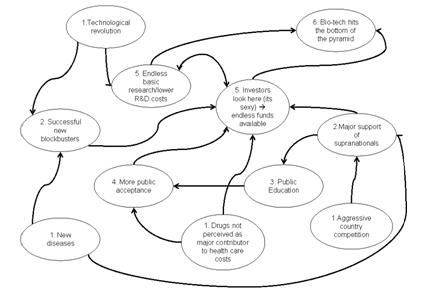Scenario BB
Biotechnology for Medical Applications in 2015 - Scenario BB: Biotech Boost
After 2005, the Biotech market for medical applications had not only achieved double digit growth rates, but also had continued to grow at an astonishing pace of 20% per year for the coming ten years. Such a high growth rate led to a market capitalization of €2,500 billion EUR by 2015 up from €300 billion EUR in 2005. Because of the continued attractiveness of the biotech market, private as well as public investors were willing to supply enormous venture capital g. Today, thanks to the enormous progress booked in research and the vast number of successful applications that have been developed, the biotech industry is able to serve the needs of the bottom of the pyramid – the 7 billion people on earth who earn less than a $1 a day.
Already in 2004 Ernst&Young’s Biotechnology report “Beyond Borders” had announced that the Biotech market would grow 20 % in 2005. Investment levels of venture capitalists, successful IPO’s and R&D were in line with this growth percentage and the biotech market as a whole had become profitable in 2008. Because of the virtually endless fundamental research that became available, after the full genetic structure of human’s was decoded, R&D costs decreased substantially. Development costs for marketable drugs had come down from $800 million in 2005 to less than $150 million. More effective (genome based) R&D had made this possible. Moreover the industry started to transfer R&D activities to low wage countries like China and India. Price levels of drugs went down, however profit margins still went up grace to the fact that development costs could be reduced so dramatically.
Thanks to the reduction of drug prices, the biotech industry managed to bring drugs out of the public focus as being the major drivers of healthcare costs. Instead of drug prices, exaggerated public hospital infrastructure and the sheer number of medical doctors and their wages were acclaimed to be responsible for the increases in healthcare costs.
However healthcare costs will again be an issue in the future: Healthcare costs in absolute terms will go up exponentially because of the still aging population. The Organisation for Economic Cooperation and Development (OECD) predicts that the percentage of 65-plus population will almost double from 13,8% to 25% in 2040.
Biotechnology has enabled medicine to become widely available to everybody – we have hit the bottom of the pyramid today – and will do so also in the future. Perspectives for those companies who are able to reduce R&D costs even more are promising. Additionally the field of orphan drugs, where relatively only a few can benefit, will continue to be attractive. Prices basically play no role in this field.
The boundaries between biotech and traditional pharmaceutical industries got closer and closer until 2010. Competition among countries in biotech research had been intense. It still is, Countries were aggressively supporting biotech companies who were willing to move research centres and production plants onshore. This was one more reason not only for the vast amount of fundamental research in biotechnology now available but also for the increasing amount of applied research conducted, and the experience and know how gained in developing and launching successful drugs. After 2010 Pharma majors desperately acquired biotech companies and transformed themselves into biotech players. Those who failed to do so have been increasingly absorbed by the biotech majors. In fact, there is hardly a difference today between biotech and traditional pharma industries.
From 2005 onwards, the world got more and more aware that new diseases had been arising faster and faster. Looking back, we can conclude that bird flu, other new types of flu, HIV and but also several new types of cancer were the most important examples. Grace to biotechnology, effective drugs could be developed fast enough to cope with these diseases and many of these drugs turned out to be blockbusters. Thanks to the quick and effective reaction of the biotech industry to these challenges the industry was able to gain major support from supranationals like the European Union and the WHO. Consequently public education in biotechnology was improved andwas broadly accepted as the answer to these new challenges. The ethical debate turned out to be in favour of the biotech industry in at least the area of medical applications. .
There may be many factors though which might slow down the growth of biotechnology. Maybe terrorism. Maybe the oil crisis. Maybe global warming. It’s just maybe, maybe…….
Scenario Diagram
Click for larger image:Biotech Boost - Scenario Diagram
